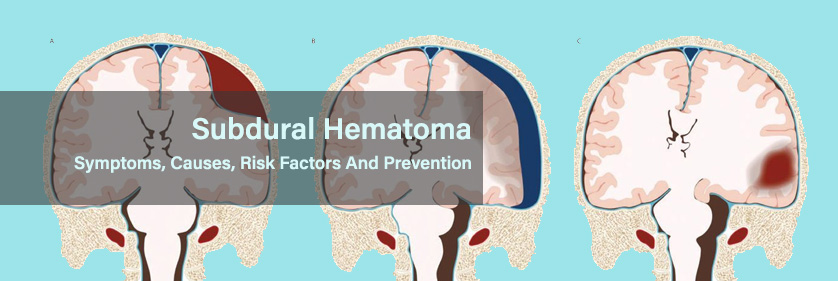Subdural Hematoma- Symptoms, Causes, Risk Factors and Prevention
What is subdural hematoma?
A subdural hematoma is a form of bleed inside your brain. More precisely, it is a form of bleeding that occurs within the skull but outside the actual brain tissue. The brain has three membranes layers or coverings (called meninges) that lay between the bony skull and the actual brain tissue. The purpose of the meninges is to cover and protect the brain.
If you have a subdural hematoma, you have experienced a tear in a blood vessel, most commonly a vein, and blood is leaking out of the torn vessel into the space below the dura mater membrane layer. This space is called the subdural space because it is below the dura. Bleeding into this space is called a subdural hemorrhage.
Many terms for subdural hematoma include intracranial hematoma or subdural hemorrhage. More broadly, it is also a type of traumatic brain injury (TBI).
Symptoms
Acute subdural hemorrhage typically occurs following serious trauma to the brain. Lesions resulting in this disorder are usually severe enough to induce a temporary loss of consciousness.
Usually, in the minutes to hours after the head injury, the person recovers consciousness. Then, the person gradually loses consciousness again, this time from subdural bleeding.
Other symptoms of the subdural hemorrhage include:
- Severe headache
- Weakness on one side of the body
- Seizures
- Changes in vision or speech
Chronic subdural hemorrhages produce more subtle symptoms. These symptoms may persist for more than a month before recognition of the diagnosis.
These symptoms include:
- Mild headache
- Nausea or vomiting
- Change in personality
- Memory loss
- Loss of balance or difficulty walking
- Double vision
- Weakness, numbness or tingling in arms or legs
The symptoms of chronic subdural hemorrhage can also imitate other common conditions. For example, they may resemble strokes and brain tumors. The gradual loss of memory and changes in personality may occasionally be mistaken for dementia.
When to seek medical attention
A life-threatening intracranial hematoma can require emergency care.
Upon a blow to the head seek urgent medical attention if you:
- Lose consciousness
- Have a persistent headache
- Experience vomiting, weakness, blurred vision, unsteadiness
If the signs and symptoms after a head blow are not immediately apparent, watch for physical, mental and emotional changes. For example, if someone seems fine after a blow to the head and can talk but later becomes unconscious, seek immediate medical care.
Also, even if you feel fine, ask someone to keep an eye on you. Memory loss following a blow to your head can make you forget the blow. Someone you say might have a greater chance of recognizing the warning signs and getting medical attention.
Causes
A serious injury to the head is the most common cause of a subdural hematoma. Small head injuries are a less common occurrence and more characteristic of older people. Often, as a consequence of another medical condition, subdural hematomas may develop spontaneously.
Risk factors
Risk factors which increase the chances for an individual to develop subdural hematoma include:
- Blood thinners, such as warfarin or aspirin
- Medical conditions that cause blood clotting issues
- Long-term alcohol use or abuse
- Repeated head injuries, for example by falling or sports
- Very young or very old age
Complications
These complications may include:
- Brain herniation that puts the brain under pressure and may cause coma or death
- Seizures
- Permanent muscle weakness or numbness
The complications range depends on the severity of your injury to the brain. Other health problems can affect chronic or acute subdural. People who take anticoagulants (blood thinners) are at higher risk. People over 65 years do have an increased risk, especially for the chronic form.
Prevention
To prevent or minimize head injury:
- Wear a helmet and make sure your kids wear helmets. Wear an appropriate and properly fitted helmet when playing contact sports, bicycling, motorcycling, skiing, horseback riding, skating, skateboarding, snowboarding or doing any activity that could result in head injury.
- Buckle your seat belt and make sure your kids are buckled in. Do so while you are driving or riding a motor vehicle.
- Protect young children. Always use properly fitted car seats, pad countertops and edges of tables, block stairways, tether heavy furniture or appliances to the wall to prevent tipping, and keep children from climbing on unsafe or unsteady objects.
